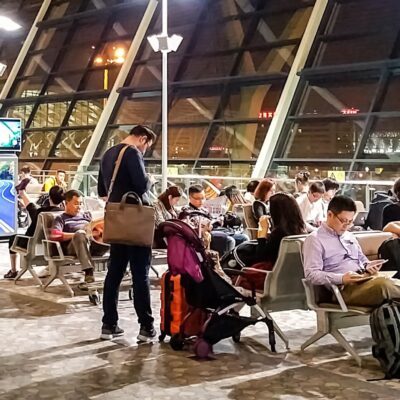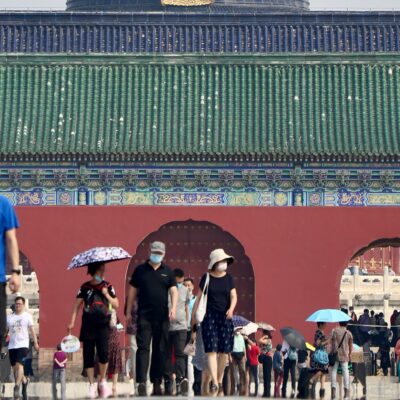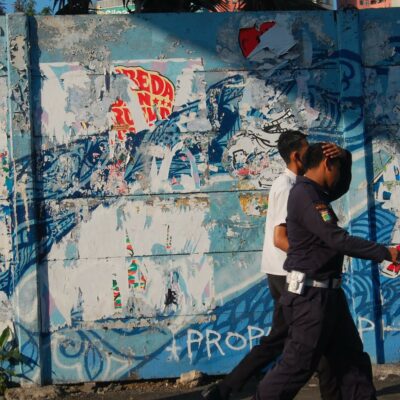‘We will strengthen our efforts to enhance and diversify the availability of pathways for safe, orderly and regular migration, including in response to demographic and labour market realities, and for migrants in vulnerable situations.’ (Paragraph 59, Progress Declaration of the International Migration Review Forum)
The COVID-19 pandemic has impacted migration and mobility in the Asia Pacific region in multiple and complex ways. Over the course of 2020-2021, various restrictions on public health grounds to halt the spread of the virus were placed on many of the available pathways for mobility. Such pathways included visas for the temporary entry of non-citizens, labour migration programmes, humanitarian entry schemes as well as refugee resettlement programmes, family unification mechanisms and other measures by which states manage the entry and stay of people in their territories. Across the region, borders were closed, often abruptly, and lockdowns in urban and rural centres confined millions to their homes for indefinite lengths of time. Forced into unemployment by business closures and contracting economies, and usually unable to carry out their jobs remotely, many migrants were forced to return to countries which struggled to reintegrate them and to include them in fragile health systems. Many faced stigma and even violence having been portrayed as ‘disease carriers’ in the countries in which they lived and worked, as well as when they returned home. This picture is rendered bleaker by the harsh fact that for many people on the move, the pandemic only exacerbated the exclusion and discrimination they routinely faced before.
The Asia Pacific region hosts and is home to a significant proportion of the world’s international migrants. According to official data, roughly one in three of the 282 million international migrants in the world originated from the region and one in seven are living in the region. To these numbers must be added a sizeable but usually uncounted population of migrants with irregular status. The region is also the world’s most populous (home to 60 percent of the global population) and among the most rapidly developing, yet it has some of the highest levels of wealth and income inequality within and between countries, some of the largest and fastest ageing populations per country, and sizeable youth populations. It is highly vulnerable to climate change and natural disasters – half of the region’s people live in low-lying coastal areas.
Migration is therefore an inevitable reality for the Asia Pacific, embedded in livelihood and risk-reduction strategies and part of the day-to-day life of millions of people who have moved in different ways and with varying motivations, as well as for the families and communities that they leave behind. Entrenched patterns of discrimination and inequality, conflict and violence, as well as poverty, socio-economic distress, family separation, and environmental degradation and climate change have long driven mobility within and from the region. Building inclusive societies, and in some cases rebuilding them, is a key post-COVID challenge; and in the landscape of Asia and the Pacific migrants are vital members of the societies in which they live. Societies and economies across Asia have been built by migrant workers, and it has been well recognised that many were essential to the COVID-19 response in the region and beyond.
Yet, international migration governance has largely been inconsistent and often fragmented, particularly in relation to protection and promotion of the human rights of migrants in situations of vulnerability. In general, regional discussions of mobility have been slow to consider the need for regular migration pathways, with some exception being made for temporary low-wage labour migration programs.
Within the Global Compact for Safe, Orderly and Regular Migration, specifically within its Objective 5, States have recognised that pathways for regular migration, including new and expanded regular pathways to admission and stay, can be an effective tool to protect migrants’ human rights. A ‘pathway’ in this context has been understood as a legal, policy and/or administrative mechanism that enables regular travel, admission and/or stay in the territory of a State. Migrants may access such pathways by obtaining the required documentation on or before arrival in a country. For those already in the territory, regular status may be secured or maintained by adjusting migration status (for example, where a status is expiring or a different suitable status is available), or by granting or regularising stay permits for migrants in an irregular situation.
Under Objective 7, the Global Compact for Migration further commits States to respond to the needs of migrants who face situations of vulnerability. The concept of migrants in vulnerable situations recognises that structural factors create precarity for some migrants, who accordingly need specific protection even if they have been compelled to leave their homes for reasons that do not fall within the international law definition of a refugee. The vulnerable situations that migrants face can arise from a range of situational and personal factors that may intersect or coexist simultaneously, influencing and exacerbating each other and evolving or changing over time as circumstances change. Migrants may find themselves in vulnerable situations because of the situations compelling them to leave their country of origin, the circumstances in which they travel or the conditions they face on arrival; or because of personal characteristics such as their age, gender identity, race, disability or health status.
In a recent report which maps national practices on entry and stay pathways in 17 countries of the Asia Pacific region, the UN Human Rights Office contends that the region needs to devise and implement pathways that respond to a range of protection-sensitive imperatives. These include the impacts of environmental degradation and climate change; health status and lack of access to health care (including the effects of pollution and other environmental threats to health); protection of the right to family life; the occurrence of torture and failure to provide rehabilitation after torture; protection from gender-based violence; situations in which migrants are witnesses to or victims of trafficking or of other crimes; and in the context of statelessness.
Common forms of protective pathways available in the region include discretionary humanitarian entry based on conditions in the country of origin or the specific circumstances of the individual migrant, temporary residence permits on medical grounds or for study (often including visas for accompanying parents or guardians); family union mechanisms; interventions to protect the rights of trafficked persons; special permits for migrants who have been victims of domestic violence; periodic or case-by-case regularisation mechanisms; and legislation enabling access to birth registration. Some countries also grant residence permits based on factors such as a migrant’s length of residence, employment, children’s school attendance, and other enduring local social ties and evidence of integration. There are, however, gaps in their implementation such as practical barriers related to cost or administrative hurdles particularly for those migrants who are structurally disadvantaged due to their gender, nationality, ethnicity or socio-economic status,
Despite protection-sensitive pathways being relatively nascent in the region, particularly those that are adjacent to or entirely outside the asylum space, it is interesting to note that of the 17 States that were covered in the study:
- 11 provide pathways that are explicitly based on human rights/humanitarian grounds.
- 16 have a form of family unification in their laws.
- 10 have comprehensive anti-human trafficking laws.
- 17 offer visas for education purposes.
- 13 provided visa amnesties to foreign nationals due to the COVID-19 pandemic.
In addition, every State included in this study granted wide-ranging residual discretionary powers to government authorities to authorise the entry and stay into the country of certain migrants or groups of migrants. Such discretionary mechanisms can be an expression of compassion or international cooperation and solidarity and are able to render flexible responses to entry and stay needs. In some jurisdictions these kinds of mechanisms currently provide the only possible pathway for migrants in vulnerable situations. However, from the perspective of international human rights best practice, systems that concentrate discretionary, often unreviewable, power in the government broadly or in the hands of the relevant Minister more narrowly, should ideally be reformed to ensure transparency, predictability and accountability. Further, the use of such discretionary power should in principle be minimal and meet a high threshold. The UN Migration Network has recommended that the decision to grant admission and stay should be based on clear and transparent criteria and not be taken solely at the discretion of the official in charge of the case to avoid discrimination and abuses of power. It is important to recall that ‘discretionary’ interventions may and often do establish grounds of admission and stay that are rooted in international human rights law and associated obligations, such as the right to family life.
Pathways that enable entry for medical treatment or to study, which are also available in many countries in the region, may in a similar vein permit migrants to realise human rights, such as the right to education or the right to health, particularly where the treatment or study is unavailable in the country of origin or where removal from the host country would cause a breach of these rights.
To make a meaningful difference to the human rights protection landscape, pathways for entry and stay need to be sufficient, accessible, and tailored to meet the needs of the region’s migrants. Where they are not, the many forces that drive migration, the high costs of regular migration, and restrictive and complex migration policies combine to create conditions of uncertainty for States and human rights risks for migrants. This mix makes the migration cycle more dangerous for migrants because they may be forced to rely on unscrupulous facilitators, or face discrimination, violence or abuse at borders; and the circumstances of individuals who are already in a vulnerable situation become more precarious.
As the study shows, the COVID-19 pandemic both reinforced the focus of States in the region on international borders as a site of visible control (including through border closures, enforced returns, quarantine policies and enhanced methods of surveillance and scrutiny) but it also provided an opportunity for governments to understand and demonstrate the flexibility and the tools that are available to them to provide regular status to migrants, particularly those who are in vulnerable situations. During the COVID-19 pandemic, many States in the region put in place innovative measures to ensure continued stay and to respond to individual situations of vulnerability, and they should seize the opportunity to embed the practices and lessons learned in this turbulent period. Indeed, the United Nations Secretary General has suggested that the pandemic offers an opportunity to reimagine human mobility for the benefit of all while advancing the central commitment of the 2030 Sustainable Development Agenda to ‘leave no one behind’.
Returning to the Progress Declaration of the Global Compact for Migration, which was recently endorsed by the United Nations General Assembly, Member States of the United Nations have agreed on the need to protect the rights, safety and dignity of migrants while promoting the security, well-being and prosperity of communities (Paragraph 5). Where policy is being made in good faith, where the primary intent of migration policy making is to address governance challenges in line with the vision of the Global Compact for Migration, then making available more and better pathways is an inevitable response.
However, the unfortunate reality in the Asia Pacific, as in other regions, is that migration policy is often made not primarily with a view to improving migration governance, but rather to influence domestic political narratives. Migrants and migration have long been held up as scapegoats in times of uncertainty and societal stress, and the COVID-19 pandemic has been no exception. Yet, the call to expand and diversify such pathways is not an argument for ‘open borders’, but rather that such pathways are a concrete demonstration of every State’s sovereign responsibility to manage their borders in a way that upholds legal obligations and principles of solidarity. Expanding and diversifying regular pathways for the entry and stay of migrants in vulnerable situations on the one hand and upholding the security and well-being of communities on the other is not a zero-sum game: enhancing the former will not lead to a diminution of the latter.
Evidence-based arguments for better migration governance will only lead to concrete and sustainable policy change if we are willing to reimagine the ways in which we speak of migration. Can we replace narratives of fear and exclusion with those of hopefulness and inclusion? Is there place in these narratives to imagine a more inclusive and resilient future for our communities? In the spirit of ‘building back better’ in the aftermath of COVID-19, governments in the Asia Pacific region must reflect on the lessons learned from the pandemic and commit to a rights-based reimagination of human mobility.
Image: Migrants arriving back at Cambodia from Thailand at Poi Pet border crossing. Credit: IOM/Flickr.




